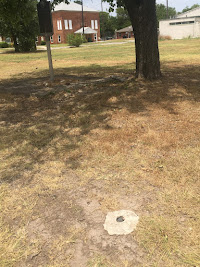On my way back from meeting Mr. Bill Webb, Sallie Capps's grandson, in Oklahoma City, I stopped by a couple of historical locations in the quaint, steadily-growing North Texas City of Gainesville. While eating a double cheeseburger from McDonalds, I walked around the former location of the Booker T. Washington School, the old Gainesville Colored School. Although only a pile of loose bricks and a historical marker remain (the facility was sadly demolished in 2014), I felt as if I had stepped back in time and was able to mix among the ghosts. In this blog post, I intend to provide a brief history of the institution that left a significant mark on Gainesville.
 |
| A photograph of the Booker T. Washington School during demolition in 2014. The brick structure was built by the WPA in 1939. (photograph from The Living New Deal) |
Island Sparks, a young mulatto whose passion for learning was infectious, began tutoring the colored children in the City of Gainesville in the early 1880s since there was only a school for white children - during the Reconstruction Era, this was the case in many Texas cities. The city's school district (created in 1882) ultimately decided to erect a school specifically for African American children in 1886. A $450 plot of land on the west side of Gainesville was chosen as the location, and the city spent $5,000 to construct a spacious two-story, wood-framed building, which was later equipped with student tables, chalkboards, and pencil boxes. Originally called the Gainesville Colored School, the facility was one of the only 19 black schools operating in Texas in the late 1880s. 186 students, ranging in ages between 5 to 17 years-old, were enrolled on the first day of classes, yet only three teachers presided over the crowded classrooms... a tragic nightmare for any educator that has faced a large, overbearing class. Despite the impressive facility, the city only allocated $5,000 for the colored school's annual budget - 1/3 of the white schools' budgets.
 |
| A photograph of the grassy site where Booker T. Washington School once stood. Notice the church and gymnasium in the background. (photograph from author's collections) |
The school's initial graduating class had four seniors. The city's renowned newspaper, the Gainesville Daily Hesperian (now known as the Gainesville Daily Register) noted the significance of the festivities: "This quartet will be the first colored graduates of the Gainesville School and will mark a noted epoch in the history of public education in the city, so far as the consideration of the colored people goes, that will forcibly remind the people of the North that the educational welfare for the colored children in Gainesville is carefully looked after by the city Board of Education." Since not many graduated from the colored institution - as students left their classes after a few years of schooling to work and support their families - exiting the school with a high school diploma became a prestigious and rare ritual. The motto for the class of 1947 reflects the school's seniors' desire to graduate and join the rank of "distinguished alumni": "Not by Brawn, by Brain." The colored school was appropriately renamed Booker T. Washington School in 1927, in honor of the esteemed African American educator and Civil Rights activist (who had peacefully died in November 1915).
The modernizing student body outgrew the original building, and a new brick structure was erected by the laborers of the Works Progress Administration in 1939 (this was part of FDR's New Deal plan to revive the American economy during the Great Depression). The Booker T. Washington School "was the center of our world, education wise and socially..." alumnus Don Williams once said in an interview. "We knew the teachers and they knew us. They were a part of our lives before, during and after school." The school had become part of the larger Gainesville story, influencing the scholarly pursuits of many talented young adults... thus, it was a tough time for students and teachers when the school closed and merged with the white schools in the city. After the monumental Brown v. Board of Education Supreme Court decision in 1954, which required all American public schools to integrate, the Gainesville School Board decided to "abolish" Booker T. Washington School and transfer its black students to the white Newsome Dougherty Memorial High School in 1965. The African American students suddenly found themselves in a different world, one that was not comforting nor supportive at first. Mr. Williams noted the difficult transition in his interview: "...it was the end of a community in which black students were suddenly in a world they did not know." The white teachers were not adequately prepared for the new black students, and their white peers often had mixed feelings on integration. The African American teachers from Booker T. Washington School were found jobs in the school district, but not necessarily in their area of expertise, initiating a significant amount of challenges for them too. In spite of the challenges, the students and teachers from the Booker T. Washington School soon thrived in their new environment as dedicated intellectuals and community leaders.
 |
| Although the Booker T. Washington school building was demolished 8 years ago, you can still notice the brick outline of the facility. (photograph from author's collections) |
After Gainesville's integration of schools, the Booker T. Washington School was boarded up and fell into disrepair. The city erected a historical marker on the property in 1986, 100 years after the colored school had opened. Alumni and staff reconvened and attended the marker ceremony. The building was razed in 2014 and most of the bricks were recycled. The surviving objects that remain in place serve as a reminder that the City of Gainesville gave young black children a quality public education when many areas of the state did not.



No comments:
Post a Comment